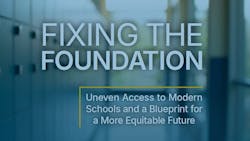Poorer districts in Massachusetts are shortchanged in building aid, report says
Key Highlights
- Suburban districts in Massachusetts received 57% of building aid invitations from 2015 to 2024, but made up only 43% of schools in the state.
- Funding practices such as funding only one project per district annually put large urban schools like Boston at a disadvantage.
- The report recommends increasing overall funds, adjusting policies for urban needs, and supporting combined community projects.
Suburban, higher-income school districts in Massachusetts have disproportionately benefited over the last decade from state building aid, a new report says.
The Boston Globe reports that the disparity in aid occurrred even though the suburbs had much lower levels of need when the state last surveyed its school facilities in 2016.
"Fixing the Foundation," the report by the nonprofit think tanks MassINC and the Worcester Regional Research Bureau, says that the suburbs account for 43% of the state’s schools, but received 57% of invites into the state agency’s main large-scale building program from 2015 to 2024.
“We’re seeing suburban districts benefiting more than our urban city schools,” said Anthony Clough, a research associate at the Worcester Regional Research Bureau and report coauthor.
Responding to the report, the Massachusetts School Building Authority (MSBA) says it is committed to working with all the cities and towns in the state "to equitably invest in funding the right-sized, most fiscally responsible and educationally appropriate solutions to create safe, sound, and sustainable learning environments."
Clough asserted that if the agency had instead prioritized the highest-needs schools over the last 10 years, it could have financed the repairs or replacement of all of them.
The report recommended a number of steps to correct that imbalance, including increasing funds for the Authority, changing its policies to better account for higher urban building costs, and allowing the Authority to pay for projects that combine schools with other community buildings like libraries.
Boston Public Schools has been at the biggest disadvantage, the report found, having five times its share of buildings with poor overall conditions but getting less than half its share of MSBA Core Program invites.
In addition to Boston,. the report found that the state's Gateway Cities, 26 midsized cities including Lawrence, Springfield, and Fall River, were also at a disadvantage. Together, Boston and the Gateway Cities make up 32% of Massachusetts schools but received less than 19% of Core Program invitations.
The disparity has a number of causes. One is the MSBA's practice of funding only one project per year, at most, from each district. That might work for a small suburban district, but it’s inadequate for the Boston school system, said Jessica Tang, the president of the American Federation of Teachers Massachusetts.
“In Boston, [with] 112 schools, if we’re doing one school per year, we will never complete improving all of our schools,” Tang said.
